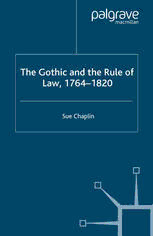
The Gothic and the Rule of Law, 1764–1820 PDF
Preview The Gothic and the Rule of Law, 1764–1820
The Gothic and the Rule of Law, 1764–1820 Sue Chaplin The Gothic and the Rule of Law, 1764–1820 This page intentionally left blank The Gothic and the Rule of Law, 1764–1820 Sue Chaplin LeedsMetropolitanUniversity ©SueChaplin2007 Softcover reprint of the hardcover 1st edition 2007 978-0-230-50755-5 Allrightsreserved.Noreproduction,copyortransmissionofthis publicationmaybemadewithoutwrittenpermission. Noparagraphofthispublicationmaybereproduced,copiedortransmitted savewithwrittenpermissionorinaccordancewiththeprovisionsofthe Copyright,DesignsandPatentsAct1988,orunderthetermsofanylicence permittinglimitedcopyingissuedbytheCopyrightLicensingAgency, 90TottenhamCourtRoad,LondonW1T4LP. Anypersonwhodoesanyunauthorisedactinrelationtothispublication maybeliabletocriminalprosecutionandcivilclaimsfordamages. Theauthorhasassertedherrighttobeidentified astheauthorofthisworkinaccordancewiththeCopyright, DesignsandPatentsAct1988. Firstpublished2007by PALGRAVEMACMILLAN Houndmills,Basingstoke,HampshireRG216XSand 175FifthAvenue,NewYork,N.Y.10010 Companiesandrepresentativesthroughouttheworld PALGRAVEMACMILLANistheglobalacademicimprintofthePalgrave MacmillandivisionofSt.Martin’sPress,LLCandofPalgraveMacmillanLtd. Macmillan(cid:2)isaregisteredtrademarkintheUnitedStates,UnitedKingdom andothercountries.PalgraveisaregisteredtrademarkintheEuropean Unionandothercountries. ISBN 978-1-349-35356-9 ISBN 978-0-230-80140-0 (eBook) DOI 10.1057/9780230801400 Thisbookisprintedonpapersuitableforrecyclingandmadefromfully managedandsustainedforestsources. AcataloguerecordforthisbookisavailablefromtheBritishLibrary. LibraryofCongressCataloging-in-PublicationData Chaplin,Sue,1967(cid:3) TheGothicandtheruleoflaw,1764(cid:3)1820/bySueChaplin. p. cm. Includesbibliographicalreferencesandindex. 1. Englishfiction“18thcentury“Historyandcriticism. 2. Horrortales,English“Historyandcriticism. 3. Englishfiction“ 19thcentury“Historyandcriticism. 4. Gothicrevival(Literature)“ GreatBritain. 5. Lawinliterature. 6. Literatureandsociety“ GreatBritain. I. Title. PR858.T3C472007 823(cid:2).08729“dc22 2006052771 10 9 8 7 6 5 4 3 2 1 16 15 14 13 12 11 10 09 08 07 For Richard Clemens This page intentionally left blank Contents Acknowledgements viii Introduction:Thresholds 1 1 FictionsofOrigin 19 2 ‘WrittenintheBlackLetter’:TheGothicand/intheRule ofLaw 37 3 SpectresofLawinTheCastleofOtranto 55 4 ClaraReeveandtheProblemofRomance 66 5 TheLaw’sGothicSpace:SophiaLee’sTheRecess 84 6 AMaternalTaleUnfolds–RadcliffeanGothic 95 7 ASupplement–GastondeBlondeville 116 8 BeforetheLaw–Godwin’sCalebWilliams 125 9 InExcess–Godwin’sStLeonandMaturin’sMelmoththe Wanderer 143 Conclusion:Frankenstein–ReproducingtheGothic 165 Bibliography 178 Index 182 vii Acknowledgements I would like to thank Leeds Metropolitan University for giving me a period of study leave to finish this book and my colleagues in the School of Cultural Studies for their professional and personal support. Thanks to Maria Drakapoulou, Dale Townsend, Avril Horner, Fred Botting, Robert Miles and to colleagues in the International GothicAssociationandtheBritishAssociationforRomanticStudiesfor constructivediscussionsduringthewritingprocess.Especialthanksalso toSharonRustonandJeromedeGrootfortheirgenerousfriendshipand collegiality. I would finally like to thank my parents, Inez and Frank, and my brother,David,fortheirloveandsupport,andmypartner,Richard,to whommorethanthanksaredue.Thisbookisdedicatedtohim. viii Introduction: Thresholds ‘Whatmanofsenseandjudgementcanreadasinglewordofthisword playwithoutsufferingwearinessofheartasatafoulsmell?’1Itisstrange, perhaps, to find that what François Hotman was describing here in 1567 was the study of law. It is odd to read early modern legal schol- arship castigating its discipline as an ‘abyss’ of ‘uncertain conjectures and tenuous divinations’ (OL, p. 1), as ‘harsh, unsavoury, unpleasant, rudeandbarbarous’.2Toitsownstudentsandpractitioners,thelawhas a ‘loathsome savour’; the study of it is ‘fearful’, ‘dangerous’ and even maddening (OL, p. 2). Richard Burton in 1628 associates the law with akindofindividualandnationalmelancholy,‘[itis]ageneralmischief ofourtimes,anunsensibleplague’(OL,pp.4–5).Theseanalysessuggest that there is possibly something of what we would term ‘the Gothic’ withintheearlymodernruleoflaw. Postmodern legal scholarship has returned to the ‘abyss’ of law, evoking certain ‘Gothic’ tropes and images in its interrogation of the law’s melancholia and mourning, its fictivity and abjection. Contem- porary critical legal theory has also begun to draw upon theoretical schema very similar to those utilised by late-twentieth-century critics of the literary Gothic. From the moment of its origin, the Gothic contestedacertainliteraryhegemonyconcernedtoprivilegeanidealof literary‘truth’,aliterary‘metaphysicsofpresence’,asitwere.3AsCostas Douzinas observes, the law has sought similarly to situate itself firmly within a ‘metaphysics of presence’; it perpetually polices its borders, spending‘unlimitedeffortandenergydemarcatingtheboundariesthat enclose law within its sovereign terrain, giving it an internal purity’.4 What critical legal theory and contemporary Gothic criticism suggest, however, is that law and literature are always already impure: ‘What is non-legal is always necessary to make the law properly legal. The 1
